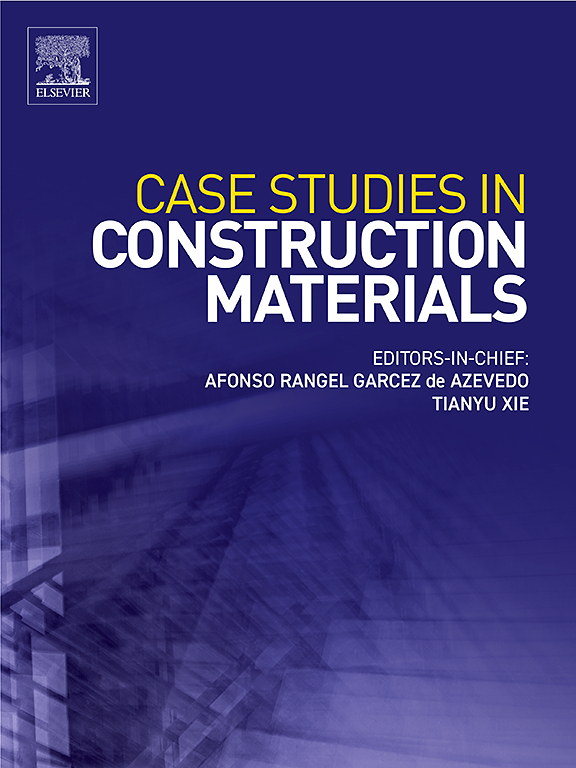Fatigue behavior and impedance spectrum characteristics of Cr-modified stainless-steel rebars after corrosion
IF 6.6
2区 工程技术
Q1 CONSTRUCTION & BUILDING TECHNOLOGY
引用次数: 0
Abstract
Corrosion and fatigue damage of rebars are the main factors affecting the durability of reinforced concrete structures. The metallurgical industry has attempted to improve the corrosion and fatigue resistance of rebars by adding or increasing the proportion of Cr in rebars. In this study, an accelerated corrosion test of a new Cr-modified stainless-steel rebar was conducted in a laboratory, and the impedance spectrum and fatigue behavior of the corroded specimens were tested. SEM and 3D scanning were employed to analyze the corrosion products and fracture morphology. Over a 40-day corrosion period, both corrosion-product formation and corrosion rate change only marginally, and a passivation film forms on the surface, enhancing the stainless-steel rebar’s corrosion resistance. The variations in the voltage within the impedance spectrum, alterations in the capacitance radius in the Nyquist diagram, and changes in the |Z| and phase angles in the Bode diagram indicate that the main chemical mechanisms in the corrosion process are the electron loss of iron and the combination of acid and base ions. The change in the P-S-N curve and analysis of the microfracture fatigue source, crack propagation zone, and transient fracture zone shows that the stainless-steel rebar still has good resistance to fatigue damage after corrosion damage. In addition, the accuracy and feasibility of a formula derived from the integration of Weibull's probability distribution model with Paris' law were validated through computational analysis. By comparing the experimental data with the calculated values of the model, the error is less than 10 %. It can be shown that properly increasing the content of Cr in stainless-steel reinforcement has a positive promotion for improving the corrosion resistance and fatigue resistance of stainless-steel rebars. This study provides a theoretical reference for improving the corrosion resistance and fatigue behavior of stainless-steel rebars after corrosion in the metallurgical field.
cr改性不锈钢钢筋腐蚀后疲劳行为及阻抗谱特征
钢筋的腐蚀和疲劳损伤是影响钢筋混凝土结构耐久性的主要因素。冶金工业试图通过在钢筋中添加或增加Cr的比例来提高钢筋的耐腐蚀和抗疲劳性能。在实验室中对一种新型cr改性不锈钢钢筋进行了加速腐蚀试验,测试了腐蚀试样的阻抗谱和疲劳行为。采用扫描电镜和三维扫描技术对腐蚀产物和断口形貌进行了分析。在40天的腐蚀周期内,腐蚀产物的形成和腐蚀速率变化不大,表面形成钝化膜,增强了不锈钢钢筋的耐腐蚀性。阻抗谱内电压的变化、Nyquist图中电容半径的变化以及Bode图中|Z|和相位角的变化表明,腐蚀过程中的主要化学机制是铁的电子损失和酸碱离子的结合。P-S-N曲线的变化以及微断裂疲劳源、裂纹扩展区和瞬态断裂区分析表明,不锈钢钢筋在腐蚀损伤后仍具有良好的抗疲劳损伤能力。此外,通过计算分析,验证了Weibull概率分布模型与Paris定律的积分公式的准确性和可行性。将实验数据与模型计算值进行比较,误差小于10 %。结果表明,适当增加不锈钢钢筋中Cr的含量,对提高不锈钢钢筋的耐腐蚀性能和抗疲劳性能有积极的促进作用。本研究为冶金领域提高不锈钢钢筋腐蚀后的耐蚀性和疲劳性能提供了理论参考。
本文章由计算机程序翻译,如有差异,请以英文原文为准。
求助全文
约1分钟内获得全文
求助全文
来源期刊

Case Studies in Construction Materials
Multiple-
CiteScore
7.60
自引率
19.40%
发文量
842
审稿时长
63 days
期刊介绍:
Case Studies in Construction Materials provides a forum for the rapid publication of short, structured Case Studies on construction materials. In addition, the journal also publishes related Short Communications, Full length research article and Comprehensive review papers (by invitation).
The journal will provide an essential compendium of case studies for practicing engineers, designers, researchers and other practitioners who are interested in all aspects construction materials. The journal will publish new and novel case studies, but will also provide a forum for the publication of high quality descriptions of classic construction material problems and solutions.
 求助内容:
求助内容: 应助结果提醒方式:
应助结果提醒方式:


